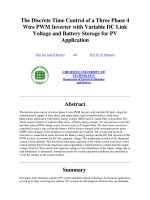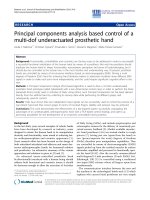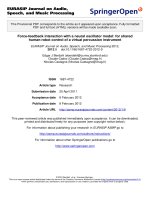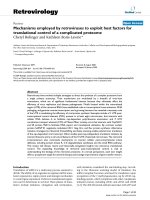Adaptive multi mode power control of a direct drive PM wind generation
Bạn đang xem bản rút gọn của tài liệu. Xem và tải ngay bản đầy đủ của tài liệu tại đây (1.95 MB, 9 trang )
IEEE JOURNAL OF EMERGING AND SELECTED TOPICS IN POWER ELECTRONICS, VOL. 1, NO. 4, DECEMBER 2013
217
Adaptive Multi-mode Power Control of a
Direct-Drive PM Wind Generation
System in a Microgrid
Lijun He, Student Member, IEEE, Yongdong Li, Member, IEEE, and Ronald G. Harley, Fellow IEEE
Abstract— This paper presents an adaptive multi-mode power
control algorithm for the converter of a direct-drive permanent
magnetic wind generation system in a microgrid. The strategy is
implemented in a field-oriented control machine drive system,
with a two-level IGBT full-power rated ac–dc machine-side
converter shown in Fig. 1. The objective of this paper control
is to operate the wind generation either in maximum power
point tracking (MPPT) mode or non-MPPT mode with enhanced
tracking performance. The simulation proves that the proposed
MPPT algorithm is faster, more robust, and adaptive to changes
of the environment than the conventional variable-step hill
climbing search algorithm, while the non-MPPT module has a
fast dynamic response to the change of the power command
and the environment, and an accurate steady-state response as
well. Moreover, the result shows that the control strategy can
automatically switch between the MPPT and non-MPPT modes.
Index Terms— Direct-drive, field-oriented control (FOC),
maximum power point tracking (MPPT), microgrid, non-MPPT,
permanent magnetic synchronous generator (PMSG).
I. I NTRODUCTION
T
HE stochastic characteristic of wind can be mitigated
by combining wind turbines and storage systems in a
microgrid connected to the utility. While in a microgrid, the
wind turbine generator is required to work in both maximum
power point tracking (MPPT) and fixed power point tracking
(non-MPPT) modes.
Conventional MPPT strategies are broadly classified into the
following types. According to the aerodynamic characteristic
of the turbine blades, which varies from one turbine design to
another, there is a unique optimal tip speed ratio (TSR) λopt for
various wind speeds to capture the maximum power Pwind_opt .
The first type of MPPT is TSR method in [1]. The basic idea
is to control the generator torque by controlling the machineside converter (MSC) to ensure an optimal rotor speed ωm_opt ,
Manuscript received June 1, 2013; revised September 23, 2013; accepted
September 25, 2013. Date of publication September 30, 2013; date of current
version October 29, 2013. Recommended for publication by Associate Editor
W. Gao.
L. He is with the School of Electrical and Computer Engineering, Georgia
Institute of Technology, Atlanta, GA 30332 USA (e-mail: ).
Y. Li is with the Department of Electrical Engineering, Tsinghua University,
Beijing 100084, China (e-mail: ).
R. G. Harley is with the School of Electrical and Computer Engineering, Georgia Institute of Technology, Atlanta, GA 30332 USA, and also
with the University of KwaZulu-Natal, Durban 4041, South Africa (e-mail:
).
Color versions of one or more of the figures in this paper are available
online at .
Digital Object Identifier 10.1109/JESTPE.2013.2284015
Fig. 1.
Topology of PMSG system with MSC.
which is obtained from the given unique λopt and wind
speed v. This type of MPPT scheme requires an anemometer
which, however, is inaccurate due to the turbulence disturbance
of the turbine blades and the variation of the wind speed along
the length of the blade [2]. The other two types of MPPT
are the power signal feedback (PSF) method in [1] and the
optimal torque (OT) method in [3]; they eliminate the need for
anemometers, but still require the parameter values of specific
wind turbines. Moreover, all the above three types of MPPT
only maximize the captured mechanical wind power Pwind , but
not the output electric power Po from the converters. The relationship of Po and Pwind is defined in (1), where ηg and ηc are
the generator and converter efficiencies, respectively, and vary
with rotor speed. Therefore, even when the optimal Pwind is
obtained, it cannot guarantee the optimal electric power Po [4]
Po = ηg ηc Pwind .
(1)
The more universal MPPT strategy is the hill climbing
search (HCS) [1]. It is particular advantageous since it not
only eliminates the need for an anemometer used in calculating
λopt in the TSR method, but also eliminates the need for
specific wind turbine parameters used in the TSR, PSF, or OT
methods. More importantly, the objective function is the output
electric power Po , instead of the captured mechanical power
Pwind . However, HCS has to make a tradeoff between the step
size and tracking speed, as well as a tradeoff between the
perturbation direction and tracking ability during wind speed
changes [4]. The variable-step HCS in [5] can solve the first
tradeoff effectively, but worsens the latter [4].
By far, the most effective MPPT algorithm is reported
in [4]; once the wind speed change is detected, the algorithm
switches from the variable-step HCS to PSF mode to avoid
unexpected large oscillations in the output power Po . Although
this algorithm is based on an uncontrolled rectifier + a dc/dc
converter topology, the most widely used topology for the
MSC is a two-level IGBT converter, as shown in Fig. 1.
2168-6777 © 2013 IEEE
218
IEEE JOURNAL OF EMERGING AND SELECTED TOPICS IN POWER ELECTRONICS, VOL. 1, NO. 4, DECEMBER 2013
In addition, since the wind generator we studied is working
in a microgrid with a limited-capacity storage system, a
specially designed non-MPPT mode is required, so as to take
over when the wind energy exceeds the limited capability of
the storage system, while the microgrid is islanded.
This paper proposes a novel adaptive multi-mode power
control scheme, specifically applied to the direct-drive
permanent magnet synchronous generator (DDPMSG) in a
microgrid, as shown in Fig. 1, with a widely used fieldoriented controlled (FOC) MSC. This controller can operate
in either MPPT or non-MPPT conditions and automatically
switches from one to the other. While in MPPT mode, this
controller is faster and more robust than the conventional
HCS method, but more importantly, it provides an excellent
tracking ability during wind speed changes; while in the
non-MPPT mode, there are three power control algorithms
proposed, that not only provide accurate steady-state power
tracking, but also fast dynamic response to the change of
the power command and environment. Sections II and III
introduce the proposed MPPT and non-MPPT algorithm,
respectively; Sections IV and V present the simulation and
experimental results; Section VI gives the conclusion.
Fig. 2.
General MPPT control based on FOC scheme.
Fig. 3.
Flow chart for the novel MPPT algorithm, on a FOC scheme.
II. N OVEL MPPT A LGORITHM
A. General MPPT Control Diagram
The topology of the DDPMSG with MSC appears in Fig. 1.
The machine’s mathematical model in the synchronous dq
reference frame is described in (2) and (3) [6]
⎧
dψd
⎪
⎪Ud = ri d + dt − ψq ω
⎪
⎨U = ri + dψq + ψ ω
q
q
d
dt
(2)
⎪ψd = L d i d + ψr
⎪
⎪
⎩
ψq = L q i q
Tem = p ψd i q − ψq i d
ω
J dω
dt = p Tem − Tl − B p
(3)
where (in physical units) u d , u q are the d and q axis voltages
of the stator, i d and i q are the d and q axis currents of the
stator, p is pole pair of the generator, ψd and ψq are the d and
q axis stator flux linkages, ψr is the rotor flux linkage, ω is
the rotor electric speed in radians/second, Tem and Tl are the
electromagnetic and load torques, L d and L q are the d and q
axis synchronous inductances, and r is the d and q axis stator
resistance.
For the widely used surface-mount PMSG, L d = L q .
Therefore, Tem = pψr i q is purely a function of i q ; while
i d only affects the excitation. This results in i d and i q being
decoupled and easy to control individually. The general MPPT
control block diagram for the MSC implemented in a typical
FOC drive system is shown in Fig. 2 and the details appear
in Section II-B. To achieve the maximum torque per ampere
at the stator terminals, i d∗ = 0.
The inputs for the MPPT controller are measured rotor
speed ωm and electromagnetic power Pem , obtained from (4);
the output from the MPPT controller is the mechanical rotor
speed reference ωm_ref [5]
Pem = Tem ωm = pψr i q ωm .
(4)
B. Novel Adaptive MPPT Methodology
Instead of purely implementing conventional HCS [1], as
mentioned in Section I, this proposed MPPT method switches
between multioperational modes, based on the detection of
wind power change. These specially designed modes bring
the benefit of adaptive tracking to environmental changes. The
one-step flow chart appears in Fig. 3.
There are three operating modes for each MPPT control
period, as classified in [4]. However, all the criteria and
methodologies in this paper are only applied to an FOC drive
system with an IGBT MSC, not the dc/dc converter in [4].
HE et al.: ADAPTIVE MULTI-MODE POWER CONTROL
Fig. 4.
change.
219
Operating point jumps from M to N with a sudden wind speed
Fig. 5. Conventional topology with wind turbine directly connected to utility.
1) No Wind Speed Change Mode 1: At the nth step, if the
tracking point is far from the MPP, the variable-step HCS
is applied as in (5) to increase the tracking speed (C is a
constant ratio). The sign of ωm_ref is determined by the signs
of ωm (n) and Pem (n) in Fig. 3
ωm_ref (n) = C | Pem (n)| .
(5)
Mode 0: The tracking approaches the MPP, ωm_ref (n) in
(5) is negligibly small and of the same order of magnitude as
the speed deviation caused by the switching of IGBTs; hence,
the object now is to keep the tracking result unchanged and
stable.
When Pem (n) < a (a is a relatively small tolerance)
ωm_ref (n) = ωm ref (n − 1) .
(6)
2) Wind Speed Change Mode 2: When a significant wind
speed change is detected, the primary challenge now is to
avoid the oscillation caused by the variable-step HCS, therefore the approximate optimal power curve Pwind_opt = k p_opt ·
3
is used, until there is no apparent wind speed change.
ωm_opt
Unlike traditional PSF, every time a switching takes place
from Mode 0 to 2, this k p_opt is updated and stored using
the variable-speed HCS searching result in mode 0, as shown
in Fig. 3. Therefore, k p_opt no longer depends on specific wind
turbine parameters. The mode 2 detection criterion is stated
as follows.
When (m Pem (n) ≥ Pem (n−1)) not ( Pem (n) < a),
(m is a relatively small ratio)
ωm_ref (n) =
3
Pem (n)
.
k p_opt
(7)
C. Wind Speed Change Detection
As illustrated in Section I, the anemometer cannot give
accurate wind speed values. On the other hand, when there
is a sudden wind speed change, the captured wind power
curve Pwind − ωm changes from curve 1 to 2 in Fig. 4;
meanwhile, due to the large inertia of the turbine, the rotor
speed ωm remains the same, therefore the captured wind
power Pwind jumps from point M to N instantaneously, which
results in an apparent change for the measured Pem (n). This
sudden change can be selected as the flag to switch from
mode 1 to 2. The criterion is described in Section II-B.
The above criterion is only applied to the detection of a
significant wind speed change. For an insignificant wind speed
change, the variable-step HCS will not lead to much oscillation
and mode 0 itself tolerates the input deviation. Moreover, the
Fig. 6.
A hybrid DC-AC link micro grid topology.
Fig. 7.
Power control mode for PMSG in microgrid.
Pem (n) in mode 2 should exceed the preset small tolerance
a in mode 0, otherwise the high ratio of Pem (n) and Pem
(n − 1) is more likely to be the result of disturbance signals,
rather than the actual wind speed change.
III. N OVEL N ON -MPPT A LGORITHM
A. Power Control Principles in Microgrid
The increased penetration of renewable generation, longdistance transmission, and the island condition of a microgrid
results in a possible weak grid connection [7]. In the conventional topology, the DDPMSG is connected through an
ac–dc–ac converter to a weak utility in Fig. 5, therefore
the generator should act as a voltage source to regulate the
dc-link voltage by adding a third voltage loop to the regular
speed control; the power generated is determined by the dc
link voltage, instead of MPPT [7].
In a microgrid with a hybrid dc–ac link, as shown in
Fig. 6, however, all distributed generators and storage systems
are connected to the dc bus. Therefore, within the capacity
of the storage system, MPPT can still be implemented for
power control strategy even in the island condition, unless one
particular condition happens, as shown in Fig. 7. From Fig. 7,
when and only when the microgrid is working as an island
with a local load, which is too small, should the DDPMSG
use the non-MPPT to reduce its power injection to the dc bus,
and protect the storage system from overcharging.
Moreover, unlike the conventional topology in Fig. 5, in an
islanded microgrid, since all distributed generators and loads
are connected at the point of common coupling, only one
device can act as the constant voltage source. For this paper,
the storage system is selected to regulate the dc bus voltage
220
IEEE JOURNAL OF EMERGING AND SELECTED TOPICS IN POWER ELECTRONICS, VOL. 1, NO. 4, DECEMBER 2013
TABLE I
C OMPARISON OF T WO O PERATING P OINTS B1 AND B2
implemented for the power loop. Apart from the difference in
transient performance, other metrics are cocnsidered in Table I
Pwind − Pacc = Po
where
dωm
.
(8)
dt
From this table, although the control for B2 is easier, it has
more losses and a maximum speed limit. In reality, the power
control for B2 includes pitch angle control; therefore, only
rotor speed control for operating point B1 is considered here.
Pacc = ωm J
B. Novel Adaptive Non-MPPT Methodology
Fig. 8.
General non-MPPT control based on FOC scheme.
Fig. 9.
Two operating points in the non-MPPT mode and power flow.
under all conditions; therefore, the MSC still acts as a current
source in the non-MPPT mode, to inject the reference fixed
amount of power into the dc bus. Hence, a PSF is added in
Fig. 8 as a third control loop.
Once the command switches from MPPT to non-MPPT, the
control strategy will switch from that shown in Fig. 2 to that
shown in Fig. 8. As plotted in the left bottom part of Fig. 9, the
captured wind power Pwind will decrease from the maximum
point Pwind_opt to the fixed amount of power Pref , so as to
prevent overcharging of the dc link capacitor.
For the given command Pref , there are two operating points,
B1 and B2 , on the mechanical wind power curve Pwind − ωm
in Fig. 9, and the actual output electric power Po is calculated,
as shown in (8) [7], ignoring losses. If the target point is
B1 , this operation requires the rotor speed ωm to decrease;
therefore, the kinetic energy decreases and Pacc < 0. From
(8), the final output electric power Po will somehow increase
in contrary to our expectation, especially considering the large
turbine inertia. This results in the storage system overcharging
the dc link capacitor even more at the very beginning, and
thus even possibly followed by oscillations, instability, and
damage to storage devices. The same analysis can be applied to
target point B2 , but Pacc this time, however, contributes to the
stability of the system; therefore, a simple PI controller can be
From the analysis in Section III-A, a third power loop
should be added to regulate the speed reference, and an
adaptive non-MPPT power control algorithm is preferably
required to eliminate oscillation and transient instability for
the target B1 .
Equation (4) shows Pem is a function of i q and ωm ; thus,
the outer power loop is coupled with the current loop and the
speed loop. The bandwidth of the speed loop is much lower;
thus, the output of the non-MPPT controller in the third loop,
the resultant speed reference ωm_ref , should respond slowly, by
setting the proportional gain for the non-MPPT PI controller
as k p = 0. The complete controller block diagram is in Fig. 8;
the non-MPPT controller with k p = 0 is in (9)
ωm_ref = ki
Perror dt = ki
(Pref − Pem ) dt
dωm_ref
= ki (Pref − Pem ) .
(9)
dt
For a traditional controller, as time goes by, the error
Perror decreases and the acceleration (dωm_ref )/dt decreases;
however, if ki [the integral gain in the controller in (9)] can be
increased, it can help to maintain the acceleration to a relative
high level to speed up the tracking. That is the basic idea of
the stage I of the adaptive PI controller. There are typically
two ways to design ki , denoted in (10) and (11), where ki_coe ,
ki_init , and r are constants and the sign of ki_coe is determined
in Fig. 10
1) Exponential Increment (IC) Adaptive PI Controller
→
ki (n) = 1 ± ki_coe · r n−1 ki_init .
(10)
2) Constant Increment (IC) Adaptive PI Controller
ki (n) = 1 ± ki_coe · (n − 1) ki_init .
(11)
As time goes by, Perror is decreasing; once Perror falls
within a small range (−b, b), where b is a small constant,
the controller switches to stage II automatically, where ki is
HE et al.: ADAPTIVE MULTI-MODE POWER CONTROL
221
TABLE II
PARAMETER S ET FOR THE PM M ACHINE IN S IMULINK
TABLE III
R ESULTS OF A S UDDEN I NCREASE I N W IND S PEED AT S TEADY S TATE
Fig. 10.
Flow chart for non-MPPT exponential IC adaptive PI controller.
Fig. 12.
Results when wind power curve has a sudden increase at t = 1 s.
bus voltage is set as 600 V, which is high enough to support
the generator within the operating speed range, using space
vector pulsewidth modulation.
A. MPPT Simulation
Fig. 11.
and C.
Various Pwind − ωm wind curves with Pwind_opt s at point A, B,
now fixed at a sufficiently large value of ki_const to boost the
speed loop reference. The flow chart for the adaptive nonMPPT controller, with stage I using (10) is shown in Fig. 10,
where ωm_ref_adapt and ωm_ref_const are the speed references for
stages I and II, respectively, and Ts is the MPPT control period.
IV. S IMULATION R ESULTS
The proposed sliding mode power controller performance is
evaluated in Simulink and results are shown in the following.
Various wind curves Pwind − ωm under different wind speeds
are plotted in Fig. 11. The blue dashed curve is denoted
as wind curve I, whereass the green dotted curve and red
solid curve are denoted as wind curve II and wind curve III,
respectively.
The parameter set for the PM machine is listed in Table II,
as specified in the Simulink PMSM model. The dc bus is
kept constant by an ideal battery model and connected to the
machine via a three-phase two-level IGBT/diode MSC. The dc
1) Sudden Wind Speed Increase at Steady State: As shown
in Fig. 12, the MPPT has already reached its steady-state
optimal speed 245.5 rad/s on wind curve II at 1 s. There is a
sudden wind speed increase and the Pwind −ωm curve changes
to wind curve III. As shown in Table III, it takes 2 s for the
variable-step HCS to track the next MPP and the optimal speed
is 260.3 rad/s, while the proposed method only needs 0.04 s,
2% time of the traditional method, to reach the steady-state
value of 261.5 rad/s. Therefore, the proposed method needs
less tracking time and results in more accurate steady-state
response (theoretically, the MPP speed for wind curve III is
261.7 rad/s, point A in Fig. 11; due to the preset tolerance in
mode 0: a = 20 W, the actual tracking point will only fall
within the vicinity of A in Fig. 11, instead of the exact point).
2) Sudden Wind Speed Decrease at Steady State: As shown
in Fig. 13, the MPPT has reached its steady-state optimal speed
270.5 rad/s at 1 s, around point A in Fig. 11. At 1 s, there is a
sudden wind speed decrease, and the Pwind −ωm curve changes
from the wind curve III to II. As shown in Table IV, the settling
time for the variable-step HCS and proposed method is the
same, but the adaptive method settles at 246.5 rad/s (closer
to point B of 245 rad/s in Fig. 11), while the conventional
method settles at a more inaccurate value of 222.0 rad/s.
222
Fig. 13.
IEEE JOURNAL OF EMERGING AND SELECTED TOPICS IN POWER ELECTRONICS, VOL. 1, NO. 4, DECEMBER 2013
Results when wind power curve has a sudden decrease at t = 1 s.
Fig. 15. Results when wind power curve has a sudden increase at t = 0.14 s.
TABLE VI
R ESULTS OF A S UDDEN D ECREASE IN W IND S PEED
B EFORE S TEADY S TATE
Fig. 14. Results when wind power curve has a sudden increase at t = 0.1 s.
TABLE IV
R ESULTS OF A S UDDEN D ECREASE IN W IND S PEED AT S TEADY S TATE
Fig. 16.
TABLE V
R ESULTS OF A S UDDEN I NCREASE IN W IND S PEED
B EFORE S TEADY S TATE
3) Sudden Wind Speed Increase Before Steady State: In this
case, the wind curve increases from the wind curve I to III
at 0.1 s in Fig. 14, before the MPP speed of 181.3 rad/s
for the present wind curve I is reached, denoted as point C
in Fig. 11. As shown in Table V, the variable-step HCS
takes 0.28 s to reach the steady state 277.5 rad/s, while the
adaptive method needs 0.23 s to reach the steady state, at
266.7 rad/s, which is also closer to the theoretical MPP speed
of 261.7 rad/s. The adaptive method under this condition needs
less setting time and tracks a value closer to the theoretical
MPP.
4) Sudden Wind Speed Decrease Before Steady State: In this
case, the wind curve decreases from the wind curve III to I at
0.14 s in Fig. 14, before the MPP speed for the original curve
has been reached, point A in Fig. 11. As shown in Table VI,
the variable-step HCS results in oscillations and takes 0.4 s to
reach the steady-state value of 136 rad/s, while the adaptive
method needs only 50% of this time to reach the steady state
of 191.5 rad/s, also closer to the theoretical MPP value of
181.3 rad/s.
Wind curves for non-MPPT simulation.
The above four cases prove that no matter how and when
wind speed changes, the proposed MPPT method always has
less setting time, less oscillation, and a more accurate steadystate response than the traditional variable-step HCS. It is also
pointed out that due to the preset tolerance a = 20 W in
mode 0, mentioned in Section II-B, as well as the power losses
between the captured mechanical wind power Pwind and output
electric power Po , the tracking results will only fall into the
vicinity of the theoretical MPP, instead of the exact point.
B. Non-MPPT Simulation
The wind curve II and III in Fig. 11 are used to demonstrate
the effect of the proposed non-MPPT controller, with a few
operation points denoted in Fig. 16.
1) Switching From MPPT to Non-MPPT: The result of
different non-MPPT controllers with a sudden command to
switch from MPPT to non-MPPT is shown in Fig. 17.
In Fig. 17, the command switches from MPPT to non-MPPT
with Pref = 1500 W at 0.5 s. The exponential and constant
IC adaptive PI controllers perform significantly better than
the traditional PI controller, greatly reducing the overshoot
and the setting time to 30%–40%. The exponential IC adaptive PI controller performs even better than the constant IC
adaptive PI, with setting time 0.0777 s, less than 0.0955 s
in Table VII. All the three controllers give accurate steadystate tracking results for point B in Fig. 16, and the whole
HE et al.: ADAPTIVE MULTI-MODE POWER CONTROL
Fig. 17.
223
Fig. 19.
Results with a sudden output power command at t = 0.5 s.
Fig. 20.
DDPMSG hardware platform.
Results when switching from MPPT to non-MPPT at t = 0.5 s.
TABLE VII
R ESULTS OF S WITCHING FROM MPPT TO N ON -MPPT
Fig. 18.
Results with a sudden wind speed change at t = 0.5 s.
system can automatically switch from MPPT to non-MPPT
mode.
2) Sudden Wind Speed Change: Fig. 18 shows that when
there is a wind speed change at 0.5 s, the wind power curve
changes from wind curve III to II; the exponential increment
(IC) adaptive PI power controller, under non-MPPT command,
takes only 0.03 s to get back to the reference power of 1500 W,
from point B to C in Fig. 16.
3) Sudden Command Change: This result is carried out with
the exponential IC adaptive controller. Fig. 19 shows that this
adaptive non-MPPT controller tracks the accurate operating
point within 0.02 s, following a sudden command change from
1500 to 2000 W, from point B to A in Fig. 16, along the
wind curve wind curve III at t = 0.5 s.
The above simulation results validate that the proposed
controller remains closed-loop stable and that it mitigates
oscillation and greatly reduces settling time at the generator
terminals, in both MPPT and non-MPPT modes. As known,
the storage system in a microgrid brings the benefit of mitigating the stochastic characteristics of the wind, sudden command
change or load change on the utility level, but its performance
strongly depends on how good the frequency response of the
storage system is. If the high-frequency power components
cannot be fully absorbed by the storage system, it will result in
fluctuation of the dc bus voltage and, to make matters worse,
these high-frequency components will be injected back into
the utility when grid connected; hence, the storage system
cannot effectively mitigate the stochastic characteristics of the
distributed generation system as one might expect.
As a conclusion, this proposed power control method mitigates the overshoot and oscillation of the generator output
power. This not only contributes to the overall input–output
efficiency and reliability [4], but also greatly limits the injected
high-frequency power components and thereby reduces the
frequency response requirements for the storage system. As
pointed out in [8], in a typical hybrid storage system, the super
capacitor acts as a fast-dynamic storage unit and is controlled
to absorb high-frequency power; while the battery acts as a
long-term storage unit to absorb low-frequency power for a
long time. Considering the fact that the super capacitor is much
more expensive than the battery, the proposed power controller
greatly reduces the required capacity of the super capacitor,
so that the total cost of the hybrid storage system is reduced.
V. E XPERIMENTAL R ESULTS
A. Experimental Platform
Tso demonstrate that the power control is practically achievable, with the dc bus voltage in the microgrid stabilized by
the battery’s voltage loop control, several tests are carried out
on the test bed, as shown in Fig. 20. The parameters for the
224
IEEE JOURNAL OF EMERGING AND SELECTED TOPICS IN POWER ELECTRONICS, VOL. 1, NO. 4, DECEMBER 2013
TABLE VIII
PMSG PARAMETERS
Fig. 22. Non-MPPT waveforms with sudden changes for power commands.
Fig. 21.
Steady state of non-MPPT waveforms.
PMSG and prime mover are presented in Table VIII. The
prime mover, which emulates a wind turbine, is controlled
by a servo motor driver; the IGBT MSC is controlled by a
DSP 28 335. The battery (one cell is 12 V, 65 AH; six cells
are serially connected) is controlled as a voltage source with
a dc bus reference Udc_ref = 150 V, using the control strategy
in [8]. The sliding rheostat acts as the dc load, with maximum
resistance Rmax ≈ 220 .
B. Experimental Results
1) Non-MPPT Steady State: The non-MPPT power tracking
steady-state result appears in Fig. 21, where CH1 is dc bus
voltage v dc , CH3 is phase a generator current i a , CH4 is dc
current i dc ; the output power Pout = v dc · i dc = CH1 · CH4.
At the steady state, the dc bus voltage remains constant and
the output power is constant, which shows that the proposed
power controller in the non-MPPT mode is closed-loop stable
in the steady state.
2) Non-MPPT With Sudden Power Command Changes: The
non-MPPT tracking results with power command changes
appears in Figs. 22 and 23. In Fig. 22, CH1, CH3, CH4, and
Pout have the same definitions as in Fig. 21. The generator
speed waveform ωm and the currents on d and q axes, i d , and
i q are shown in Fig. 23.
In Fig. 22(a), since the power command is doubled, the
measured output power first increases from 66.2 to 134.2 W.
After a while, according to another power command change,
the output power steps down, back to the nominal value.
Moreover, since the input prime mover torque is constant, the
amplitude of the generator current in CH3 i sa in Fig. 22(b)
and the generator currents in d and q axes in Fig. 23, i d
and i q , remain unchanged at different power commands in
steady state; only the current frequency as well as the rotor
speed is doubled to inject more active power in Fig. 22(b)
or reduced to 50% to inject less power. The above results
show that the non-MPPT power controller is still able to track
the desired power while the command is varying and that
Fig. 23.
Speed waveform, with power command reduced by 50%.
the closed loop control remains stable at both power levels.
The high-frequency components of the overshoot will be
absorbed by super capacitors in the future work.
VI. C ONCLUSION
This paper proposed a novel adaptive multi-mode power
control algorithm for DDPMSG in a microgrid with a hybrid
dc–ac link topology, implemented in a typical FOC drive
system with a two-level IGBT MSC. The simulation and
experimental results prove that both the MPPT and non-MPPT
modes have significant advantages over traditional controllers;
they are more adaptive, robust, and accurate, especially during
unexpected changes of wind speed and power command; the
two modes can slide automatically under different conditions.
With this novel adaptive power controller in a microgrid, the
stochastic impact of the wind energy can be limited both on the
utility level and microgrid level. It will enhance the efficiency
and reliability of the whole system and reduce the frequency
requirements and cost of the storage system, therefore making
the wind energy not only environmentally friendly, but also
grid friendly.
HE et al.: ADAPTIVE MULTI-MODE POWER CONTROL
R EFERENCES
[1] I. K. Buehring and L. L. Freris, “Control policies for wind energy
conversion systems,” IEE Proc., C, Generat., Transmiss. Distrib.,
vol. 128, no. 5, pp. 253–261, Sep. 1981.
[2] L. Y. Pao and K. E. Johnson, “A tutorial on the dynamics and control of
wind turbines and wind farms,” in Proc. Amer. Control Conf., St. Louis,
MO, USA, Jun. 2009, pp. 2076–2089.
[3] S. Morimoto, H. Nakayama, M. Sanada, and Y. Takeda, “Sensorless
output maximization control for variable-speed wind generation system
using IPMSG,” IEEE Trans. Ind. Appl., vol. 41, no. 1, pp. 60–67,
Jan. 2005.
[4] S. M. R. Kazmi, H. Goto, H.-J. Guo, and O. Ichinokura, “A novel
algorithm for fast and efficient speed-sensorless maximum power
point tracking in wind energy conversion systems,” IEEE Trans. Ind.
Electron., vol. 58, no. 1, pp. 29–36, Jan. 2011.
[5] Y. Jia, Z. Yang, and B. Cao, “A new maximum power point tracking
control scheme for wind generation,” in Proc. PowerCon, Kunming,
China, Oct. 2002, pp. 144–148.
[6] Z. Zheng, “Research of PMSM high performance control and mechanical sensorless operation,” Ph.D. dissertation, Dept. Electr. Eng.,
Tsinghua Univ., Beijing, China, 2008.
[7] X. Yuan, F. Wang, D. Boroyevich, Y. Li, and R. Burgos, “DC-link
voltage control of a full power converter for wind generator operating
in weak-grid systems,” IEEE Trans. Power Electron., vol. 24, no. 9,
pp. 2178–2192, Sep. 2009.
[8] B. Dong, Y. Li, and Z. Zheng, “Control strategies of DC-bus voltage in
islanded operation of microgrid,” in Proc. 4th Int. Conf. Electr. Utility
DRPT, Weihai, China, Jul. 2011, pp. 1671–1674.
Lijun He (S’12) received the B.S. degree in electrical engineering from Tsinghua University, Beijing,
China, in 2011. She is currently working toward the
Ph.D. degree with the School of Electrical and Computer Engineering, Georgia Institute of Technology,
Atlanta, GA, USA.
Her current research interests include control, design and condition monitoring of electric
machines, and renewable energy.
225
Yongdong Li (M’08) received the B.S.E.E. degree
from the Harbin Institute of Technology, Harbin,
China, in 1982, and the M.S.E.E. and Ph.D. degrees
from the Department of Electrical Engineering, Institute National Polytechnique de Toulouse, Toulouse,
France, in 1984 and 1987, respectively.
He has been a Professor with Tsinghua University,
Beijing, China, since 1996, and an Invited Professor
with Institute National Polytechnique de Toulouse,
Toulouse. He has authored or co-authored more than
200 conference and journal papers, and two monographs on digital control of ac motor and multilevel converter. His current
research interests include power electronics, power converter topologies,
machine control, and wind power generation.
Dr. Li is a Senior Member of the China Electro-Technique Society, the Vice
Chairman of the China Power Electronics Society, and a Vice Chairman of
the Electrical Automation Committee of China Automation Association.
Ronald G. Harley (M’77–SM’86–F’92) received
the M.Sc.Eng. degree (cum laude) in electrical engineering from the University of Pretoria, Pretoria,
South Africa, in 1965, and the Ph.D. degree from
the University of London, London, U.K., in 1969.
He was appointed to the Chair of electrical
machines and power systems with the University of
Natal, Durban, South Africa, in 1971. He is currently
a Regents’ Professor and Duke Power Company
Distinguished Professor with the School of Electrical and Computer Engineering, Georgia Institute of
Technology, Atlanta, GA, USA. He has published over 600 papers in the field
and presented several key-note papers. He holds six U.S. patents. His current
research interests include the dynamic behavior and condition monitoring
of electric machines, motor drives, power systems, and their components
and controlling them by the use of power electronics and intelligent control
algorithms, as well as the design of electric machines.
Dr. Harley is a fellow of the Institution of Engineering and Technology,
U.K., and the Royal Society in South Africa, and a member of the Academy
of Science in South Africa. He received the Cyril Veinott Electromechanical
Energy Conversion Award from the IEEE Power Engineering Society for
outstanding contributions to the field of electromechanical energy conversion
in 2005 and the IEEE Richard H. Kaufmann Field Award with a citation For
contributions to monitoring, control and optimization of electrical processes
including electrical machines and power networks in 2009.









